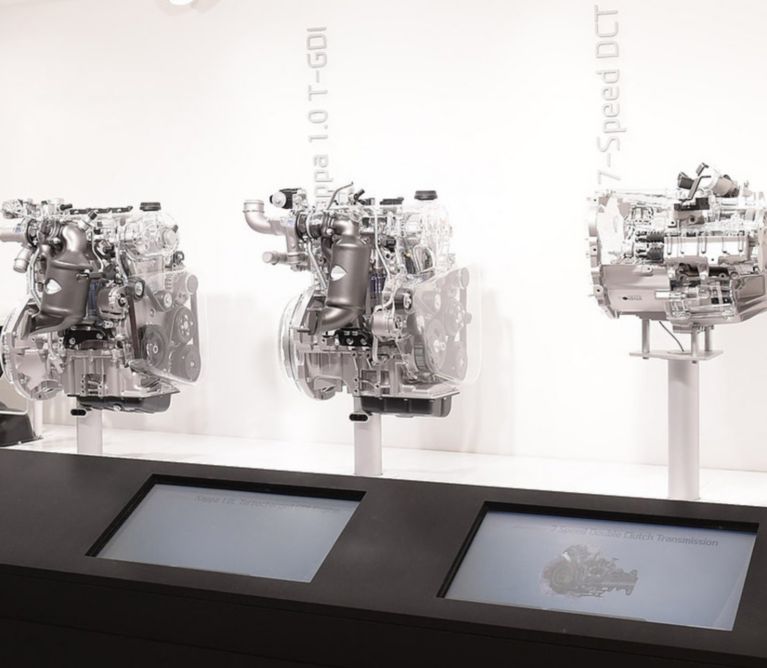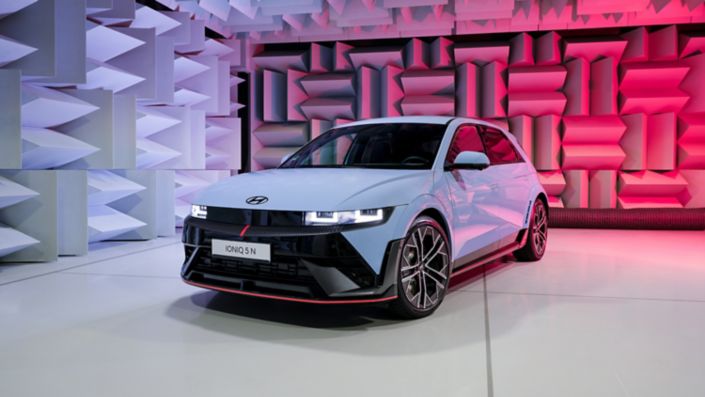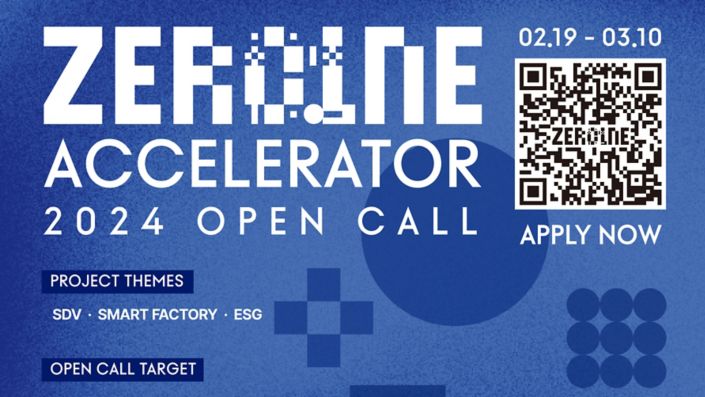- New Generation i20 to be equipped with new 1,0-litre turbocharged three cylinder gasoline engine in 2015
- Newly developed 1,4-litre T-GDI engine to be showcased in i30 CNG concept car
- First seven-speed dual-clutch transmission on display
Press material
-
Download
Hyundai Motor is showcasing two new turbocharged gasoline direct injected (T-GDI) engines at the Paris Motor Show 2014.
Both engines – 1,0-litre and 1,4-litre units which are part of a new generation of engines from the Kappa family – meet growing demand for small capacity, turbocharged engines to reduce fuel consumption and CO2 emission without compromising on driving pleasure.
In addition, Hyundai premieres at the Paris show its first seven-speed dual-clutch transmission, fitted into the i30 CNG concept car, which contributes to improved fuel efficiency.
The new Kappa 1,0-litre T-GDI is the first of a new generation of small turbocharged gasoline engines, offering enhanced performance, driving pleasure and efficiency. The 998 cc three-cylinder unit is based on the established Kappa 1,0 litre MPI engine, carrying various enhancements and new technologies, including direct gasoline injection and a small, single-scroll turbocharger.
The 1,0 litre T-GDI engine, which was developed in Hyundai’s European Technical Center in Rüsselsheim, is able to produce up to 120 PS and 172 Nm of torque and will enhance the New Generation i20 engine line-up in 2015.
The new engine comes with an electronically-controlled waste-gate to optimise flow and improve low-end torque and throttle response. The unit features a six-hole GDI injector, pressured to a higher-than-average 200 bar, securing a clean combustion and improving fuel economy and emissions to fulfil Euro 6c emission standards, three years ahead of their introduction in 2017.
It uses a new split-cooling concept to manage different temperatures in the cylinder head and block area. The cylinder block is heated up quickly for lower friction and more efficient run, while the cylinder head is operating at lower temperatures to optimise injection and combustion. To keep the engine unit as small as possible, the exhaust manifold is integrated within the cylinder head and can therefore be cooled efficiently using the cylinder head water cooling system. These efforts result in faster warm-up of the catalyst and ultimately in reduced real-world fuel consumption and emissions.
The second engine to be showcased at the Paris Motor Show 2014 is the Kappa 1,4-litre T-GDI unit. This newly developed 1352 cc four-cylinder turbocharged gasoline engine is significantly lighter than its predecessor, the Gamma 1,4-litre engine. At only 87 kg, the engine’s base weight has been reduced by 14 kg compared to the Gamma 1,4-litre unit. As well as being lighter and smaller, it features greater efficiency and power.
The new 1,4-litre T-GDI engine incorporates a sophisticated high-pressure single-scroll turbocharger integrated within the exhaust manifold to improve operational efficiency. The relocated and re-engineered turbo means throttle response time and low-end torque have improved. The new design injects fuel directly inside the cylinder, improving combustion rates for better power and fuel efficiency.
Showcased in the i30 CNG concept car displayed on Hyundai’s Paris Motor Show booth, the Kappa 1,4-litre T-GDI engine provides 117 PS in CNG mode, delivering 206 Nm of torque. The CO2 emissions of the i30 CNG concept car are just 87 g/km, already now meeting the strict Euro 6c emission standards.
Another premiere at the Paris Motor Show 2014 is the seven-speed dual-clutch transmission (7DCT), also showcased in the i30 CNG concept car. It is the first time that Hyundai is presenting a dual-clutch transmission with seven gears, combining the benefits from automated and manual transmissions. The 7DCT provides an improvement in fuel consumption and CO2 emission compared to a conventional six-gear automated transmission, while acceleration performance increases.
The 7DCT consists of two dry clutches and an actuator for each clutch, and engine power is transferred independently into the odd and even gear train to always be ready to shift into the next gear without any torque interruption. For optimized responsiveness the electric motor-driven actuator is applied, while external damper improve the noise vibration harshness during driving.
In addition, Hyundai premieres at the Paris show its first seven-speed dual-clutch transmission, fitted into the i30 CNG concept car, which contributes to improved fuel efficiency.
New 1,0-litre T-GDI to premiere in New Generation i20 in 2015
The new Kappa 1,0-litre T-GDI is the first of a new generation of small turbocharged gasoline engines, offering enhanced performance, driving pleasure and efficiency. The 998 cc three-cylinder unit is based on the established Kappa 1,0 litre MPI engine, carrying various enhancements and new technologies, including direct gasoline injection and a small, single-scroll turbocharger.
The 1,0 litre T-GDI engine, which was developed in Hyundai’s European Technical Center in Rüsselsheim, is able to produce up to 120 PS and 172 Nm of torque and will enhance the New Generation i20 engine line-up in 2015.
The new engine comes with an electronically-controlled waste-gate to optimise flow and improve low-end torque and throttle response. The unit features a six-hole GDI injector, pressured to a higher-than-average 200 bar, securing a clean combustion and improving fuel economy and emissions to fulfil Euro 6c emission standards, three years ahead of their introduction in 2017.
It uses a new split-cooling concept to manage different temperatures in the cylinder head and block area. The cylinder block is heated up quickly for lower friction and more efficient run, while the cylinder head is operating at lower temperatures to optimise injection and combustion. To keep the engine unit as small as possible, the exhaust manifold is integrated within the cylinder head and can therefore be cooled efficiently using the cylinder head water cooling system. These efforts result in faster warm-up of the catalyst and ultimately in reduced real-world fuel consumption and emissions.
New Kappa 1,4-litre T-GDI engine
The second engine to be showcased at the Paris Motor Show 2014 is the Kappa 1,4-litre T-GDI unit. This newly developed 1352 cc four-cylinder turbocharged gasoline engine is significantly lighter than its predecessor, the Gamma 1,4-litre engine. At only 87 kg, the engine’s base weight has been reduced by 14 kg compared to the Gamma 1,4-litre unit. As well as being lighter and smaller, it features greater efficiency and power.
The new 1,4-litre T-GDI engine incorporates a sophisticated high-pressure single-scroll turbocharger integrated within the exhaust manifold to improve operational efficiency. The relocated and re-engineered turbo means throttle response time and low-end torque have improved. The new design injects fuel directly inside the cylinder, improving combustion rates for better power and fuel efficiency.
Showcased in the i30 CNG concept car displayed on Hyundai’s Paris Motor Show booth, the Kappa 1,4-litre T-GDI engine provides 117 PS in CNG mode, delivering 206 Nm of torque. The CO2 emissions of the i30 CNG concept car are just 87 g/km, already now meeting the strict Euro 6c emission standards.
Seven-speed dual-clutch transmission
Another premiere at the Paris Motor Show 2014 is the seven-speed dual-clutch transmission (7DCT), also showcased in the i30 CNG concept car. It is the first time that Hyundai is presenting a dual-clutch transmission with seven gears, combining the benefits from automated and manual transmissions. The 7DCT provides an improvement in fuel consumption and CO2 emission compared to a conventional six-gear automated transmission, while acceleration performance increases.
The 7DCT consists of two dry clutches and an actuator for each clutch, and engine power is transferred independently into the odd and even gear train to always be ready to shift into the next gear without any torque interruption. For optimized responsiveness the electric motor-driven actuator is applied, while external damper improve the noise vibration harshness during driving.
Consumption Data*
i20
Gasoline Engines
1.25 MPI (75 PS): Fuel consumption combined: 5.1 - 4.7 l/100 km; urban: 6.6 - 5.8 l/100 km; extra-urban: 4.2 - 4.0 l/100 km; CO2 emissions combined: 119 - 109 g/km
1.25 MPI (84 PS): Fuel consumption combined: 5.1 - 4.7 l/100 km; urban: 6.6 - 5.8 l/100 km; extra-urban: 4.2 - 4.0 l/100 km; CO2 emissions combined: 119 - 109 g/km
1.4 MPI (100 PS): Fuel consumption combined: 6.4 - 6.2 l/100 km; urban: 8.5 - 8.2 l/100 km; extra-urban: 5.1 - 4.8 l/100 km; CO2 emissions combined: 148 - 143 g/km
1.0 T-GDi (100 PS): Fuel consumption combined: 4.6 - 4.0 l/100 km; urban: 5.8 - 5.0 l/100 km; extra-urban: 3.9 - 3.4 l/100 km; CO2 emissions combined: 107 - 94 g/km
1.0 T-GDi (120 PS): Fuel consumption combined: 5.0 - 4.6 l/100 km; urban: 6.3 - 5.8 l/100 km; extra-urban: 4.2 - 3.9 l/100 km; CO2 emissions combined: 115 - 107 g/km
Diesel Engines
1.1 CRDi (75 PS): Fuel consumption combined: 4.0 - 3.2 l/100 km; urban: 4.9 - 3.4 l/100 km; extra-urban: 3.4 - 3.0 l/100 km; CO2 emissions combined: 103 - 83 g/km
1.4 CRDi (90 PS): Fuel consumption combined: 4.1 - 3.7 l/100 km; urban: 4.9 - 4.5 l/100 km; extra-urban: 3.5 - 3.3 l/100 km; CO2 emissions combined: 106 - 97 g/km
*Depending on trim and tire specifications.











